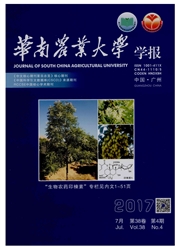

 中文摘要:
中文摘要:
针对吉林省西部新垦水田地盐碱化严重等问题,研究了脱硫石膏( GR)、沙土( SS)、农家肥( FM)、混合( M)4种处理对苏打碱土新垦水田的改良作用.结果表明:M处理的水稻株高与SS、FM、对照( CK)间存在极显著差异(P<0.01);GR处理的水稻根长、叶面积指数与CK、FM存在极显著差异(P<0.01);M和GR处理水稻株高、根长和叶面积指数差异不显著,表明M处理中的脱硫石膏成分对土壤改良的贡献率最大,进而影响水稻的形态特征.M处理的水稻根生物量最高,GR处理的水稻茎、叶、穗生物量和总生物量最高,并且与CK间存在极显著差异( P<0.01).在改良12个月后,0~20 cm土层土壤的pH在M与CK间存在显著差异(P<0.05);CK、SS与GR处理间EC值差异极显著(P<0.01).在改良17个月后,M与CK间土壤pH存在极显著差异(P<0.01);CK、FM和SS处理与GR、M处理间EC、ESP值存在极显著差异(P<0.01),M处理的EC值最高、ESP最低.GR处理水稻产量达到6071 kg/hm2.
 英文摘要:
英文摘要:
Effects of different treatments ( desulfurization gypsum ( GR ) , sandy soil ( SS ) , farm manure (FM) and mixed(M)) on new reclamation paddy field amelioration of soda alkaline soil were studied for these serious problems of soil salinization .The results showed that the rice height in M treatment differed significantly from SS, FM and control (CK) treatments (P〈0.01);the root length and leaf area index in GR treatment differed significantly from control and FM treatments , the rice height , root length and leaf area index in M treatment did not have significant differences from GR treatment , which indicated that GR had the largest contribution to soil amelioration and affected morphological characteristics of rice . The root biomass of M treatment was the maximum , and the stem, leaf, spike and total biomass of GR treatment were the maximum , which differed significantly from CK .Soil pH of 0-20 cm in M treatment differed from CK ( P〈0.05 ); differences in electric conductivity ( EC ) among CK , SS and GR treat-ments were statistically significant ( P〈0.01) after amelioration of 12 months, but the soil pH in M treatment differed significantly from CK (P〈0.01), the maximum EC and minimum exchangeable sodi-um percentage ( ESP) were observed in M treatment;the EC and ESP of CK , FM and SS treatments dif-fered from GR and M treatments after amelioration of 17 months.The rice yield was 6 071 kg/hm2 in GR treatment .The most economic way was GR treatment in terms of cost savings , amelioration and produc-tion increase .
 同期刊论文项目
同期刊论文项目
 同项目期刊论文
同项目期刊论文
 Study on capillary rise from shallow groundwater and critical water table depth of a saline-sodic so
Study on capillary rise from shallow groundwater and critical water table depth of a saline-sodic so Field-Scale Spatial Variation of Saline-Sodic Soil and Its Relation with Environmental Factors in We
Field-Scale Spatial Variation of Saline-Sodic Soil and Its Relation with Environmental Factors in We MEASUREMENT AND ESTIMATION OF CAPILLARY RISE FROM GROUNDWATER OF SALINE-SODIC SOIL IN THE WESTERN SO
MEASUREMENT AND ESTIMATION OF CAPILLARY RISE FROM GROUNDWATER OF SALINE-SODIC SOIL IN THE WESTERN SO 期刊信息
期刊信息
